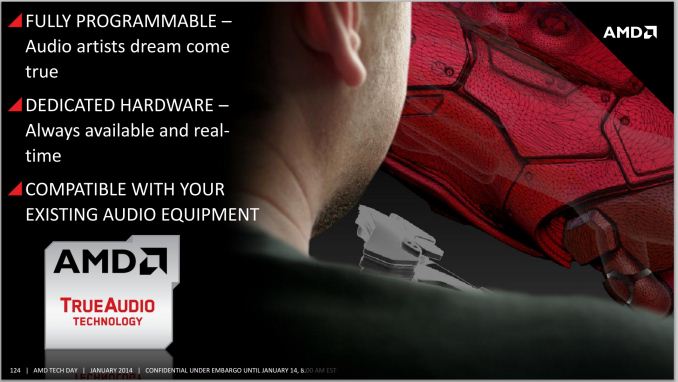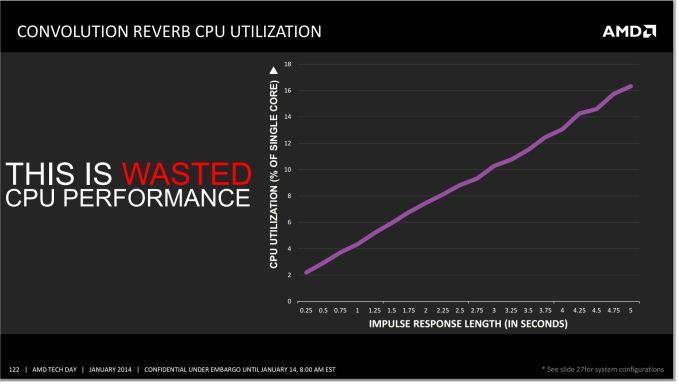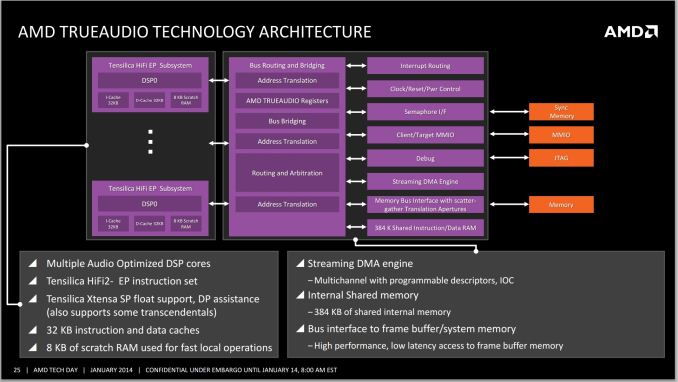AMD Kaveri Review: A8-7600 and A10-7850K Tested
by Ian Cutress & Rahul Garg on January 14, 2014 8:00 AM ESTTrueAudio
As part of the Kaveri package, AMD is also focusing on adding and updating their fixed function units / accelerators. Due to the jump on the GPU side to GCN we now have the TrueAudio DSP to allow developers to increase the audio capabilities in game, and both the Video Codec Engine (VCE) and Unified Video Decoder (UVD) have been updated.
All the major GPU manufacturers on the desktop side (AMD, NVIDIA, Intel) are pushing new technologies to help improve the experience of owning one of their products. There are clearly many ways to approach this – gaming, compute, content consumption, low power, high performance and so on. This is why we have seen feature like FreeSync, G-Sync, QuickSync, OpenCL adoption and the like become part of the fold in terms of these graphics solutions.
AMD’s new feature is TrueAudio - a fully programmable dedicated hardware element to offload audio tasks to.
The main problem with developing new tools comes down to whether they should be implemented in a general fashion or with a dedicated element. This comes down to the distinction of having a CPU or an ASIC do the work – if the type of work is specific and never changes, then an ASIC makes sense due to its small size, low power overhead and high throughput. A CPU wins out when the work is not clearly defined and it might change, so it opens up the realm of flexibility in exchange for performance per watt.
CPUs are now significantly powerful that a range of audio based techniques are available to them and the algorithms are optimized. The only limitation in this regard is the imagination of the developer or audio artist, which actually becomes part of the problem. When implementing an audio filter on the fly to a video game, the processing via the CPU can be overly taxing, especially when the effect is persistent over a long time. The example AMD gave in their press slide deck is one of adding reverb to an audio sample. The longer the reverb, the bigger the draw on CPU resources:
AMD cites this CPU usage as the effect of one filter on one audio sample. Imagine being in a firefight situation in a video game, whereby there are many people running around with multiple gunshots, splatter audio and explosions occurring. Implementing effects on all, and then transposing audio location to the position of the character is actually computationally expensive, all for the sake of realism. This is where the TrueAudio unit comes into play – the purpose is to offload all of this onto a dedicated bit of silicon that has the pathways built in for quicker calculations.
TrueAudio is also implemented on AMD's latest-generation R9 260 and R9 290 video cards – basically anything at least GCN 1.1 and up. Meanwhile we also know that the PS4’s audio DSP is based on TrueAudio, though given the insular nature of console development it's not clear whether the APIs are also the same on both platforms. AMD for their part is working with major audio middleware plugins (wwise, Bink) in order to help develop the TrueAudio ecosystem, so even in the case where the APIs are dissimilar, middleware developers can abstract that and focus on the similarities in the hardware underneath.
As is usually the case for these additional hardware features, games will need to specifically be coded to use TrueAudio, and as such the benefits of TrueAudio will be game specific. At the same time there are not any games currently on the market that can take advantage of the feature, so the hardware is arriving before there is software ready to use it. The first three games on AMD's list that will support TrueAudio are Murdered: Soul Suspect, Thief, and Lichdom. Much like FreeSync, I expect the proof is in the pudding and we will have to wait to see how it can affect the immersion factor of these titles.
Unified Video Decoder and Video Codec Engine
I wanted to include some talk about the UVD and VCE with Kaveri as both are updated – we get UVD 4, an update to error resiliency for H.264, and VCE 2, as shown below:
Of the two blocks, the improved VCE has the more interesting improvements to discuss. With the addition of support for B frames in H.264 encoding, the resulting ability to do backwards frame prediction should help improve the resulting image quality from VCE and/or reduce the required bitrates for any given quality level. Meanwhile the addition of support for the higher quality YUV444 color space in the H.264 encoder should help with the compression of primarily linear lineart/text, which in turn is important for the clarity of wireless displays.





















380 Comments
View All Comments
Ian Cutress - Tuesday, January 14, 2014 - link
I did a look back to C2D this time last year: http://www.anandtech.com/show/6670/dragging-core2d...When I get into the swing of testing for Gaming CPU viability again, I'll make sure it is part of the testing matrix.
ImSpartacus - Tuesday, January 14, 2014 - link
I've been reading Anadtech since I was in high school and that has to be my favorite article. I reference that article constantly.It's so hard to find reliable & exhaustive benchmarks of old CPUs. If you could update it every 2 years, I would love you forever!
just4U - Tuesday, January 14, 2014 - link
I read that article and it got me to thinking.. Maybe what is needed is not a direct comparison with new and competing products (which companies may not like..) but rather something stand alone that gets refreshed like your E6400 article. It sets the bar on what the reviewer (and likely most of us) think is needed these days..I know for myself I see a lot steps sideways in the computer industry but it's no longer leaps ahead like it once was.alyarb - Wednesday, January 15, 2014 - link
That would be great. I have a C2Q at 3.7 GHz and a 5850 at 800 MHz. Sure, that is >350W under load, but it still gets the job done at 1080p even in 2014. I have tried and can't justify replacing it all just yet.Similarly I'm not surprised to see Llano is not at the bottom of these charts and is still within striking distance of Kaveri in a lot of the tests. One day I'd like to see the past 8 or 10 years of CPUs all put through the same battery of 2013-2014 tests.
Integration and new features are all welcome, but let's take a look, as performance skeptics, at how far we've really come all this time.
anubis44 - Saturday, January 18, 2014 - link
"I have a C2Q at 3.7 GHz and a 5850 at 800 MHz. Sure, that is >350W under load, but it still gets the job done at 1080p even in 2014. I have tried and can't justify replacing it all just yet."Try playing Company of Heroes 2 (my current favourite) on that rig, and understand the meaning of the word 'obsolete'. That game will bring that system to it's knees, and it won't be pretty.
just4U - Sunday, January 19, 2014 - link
Throw in a 760 or a 280x then.. see if it's still brought to it's knees.. Hell a 270/x might do.. it's substantially faster than the 5850 as well.SofS - Friday, January 17, 2014 - link
Careful when comparing older processors regarding the memory subsystem since without the integrated controller they are very sensitive to memory performance or at least my C2Q 9550 @3410MHz seems to be. In my case the upgrade to to a G.Skill F3-12800CL6-2GBXH dual kit I made some years ago was meaningful and some other readers here on similar platforms might find that only upgrading the RAM would give them headroom enough to avoid a whole new system purchase for a while longer. Currently I also own a i7-4800MQ based notebook with dual KHX1600C9S3/8G and while noticeably faster for some cases it does not really enable me to game at higher settings than my desktop system given the GPU being a GTX 765M. Going forward a GPU upgrade to the desktop system is all I am looking for.RussianSensation - Friday, January 17, 2014 - link
Sorry, but you may have a confirmation bias here. You bought new memory expecting the system to perform much faster but years and years of personal ownership of C2D/C2Q systems and online reviews show that it hardly performed faster with faster memory. That architecture in fact performed faster with tighter latency. Your kit doesn't even have 5-5-5-15 timings. C2Q 9550 @ 3.4ghz is a slow CPU compared to Core i7 4770 @ 4.5ghz for gaming. Your memory upgrade may have netted you an extra 2-3% increase on average at best.SofS - Friday, January 17, 2014 - link
Come to think of it, maybe the amount was more important, besides going down to CL6 previously it was 2x1GB instead of 2x2GB. If that is the case then my 765M must be holding the 4800MQ back for gaming or something else is very wrong. Currently the only games I play that do not perform properly at 1080p are Witcher2 and Tomb Raider, probably that has more to do with the GPU than the CPU/RAM tough the real question is if a better next generation mid range GPU would still be able to work properly with them.Albangalo - Wednesday, January 15, 2014 - link
While it's not to do with Kaveri, Tom's Hardware did some articles comparing current cpus with older ones:Intel Ivy vs c2d & c2q: http://www.tomshardware.com/reviews/ivy-bridge-wol...
AMD fx vs k10: http://www.tomshardware.com/reviews/piledriver-k10...